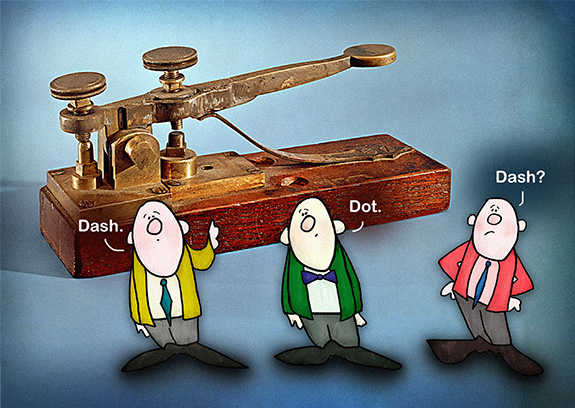It is 1860, and my Aunt Bessie is moving to Ketchum, Idaho.
How will I ever talk to her again?
Well. Back then. You couldn’t. A letter could have been written to Aunt Bessie. But it would have to travel by overland stagecoaches. Travel by stagecoach from the East Coast (e.g., New York) to the West Coast (e.g., San Francisco) could take several weeks to a couple of months, depending on the route, weather conditions, and other factors. The Pony Express improved things, but that service only lasted about a year, from April 1860 to October 1861.
So by the time Aunt Bessie got my letter, and then by the time she wrote me back, six months time may have passed. And a lot happens in six months.
But then came along Samuel Morse. It was on this date, October 22, 1861, when the first telegraph line linking the West and East coasts of America was completed. Remarkably, I could have sent a message to Aunt Bessie in no time at all. Stop. I got my period. Stop. Gross. Stop. I wish it would stop. Stop.
The telegraph was invented in the early 19th century. Developed by Samuel Morse and Alfred Vail. As it went, they demonstrated their telegraph system in 1837. Things took a little time to roll out, but the first successful long-distance telegraph message was sent on May 24, 1844, when Morse famously sent the message “What hath God wrought” from Washington, D.C., to Baltimore, Maryland. Woot. They said. Woot.
This grand achievement marked the beginning of the practical use of telegraphy for long-distance communication. So now, Aunt Bessie wasn’t so far out of reach. A message could be sent to her in minutes. Not months.
A telegraph is a communication system that transmits messages over long distances using electrical signals. Roughly, it works like this. At one end, an operator would use a switch to open and close an electrical circuit. This key was used to send coded messages. Those signals would travel across telegraph lines, often consisting of wires strung between telegraph poles. From two feet to two thousand miles.
At the other end, the receiving end, there was another telegraph instrument, often with a paper tape or a visual indicator, that could reproduce the coded message sent from the transmitting end. And, of course, they used Morse code to create the messages. Each letter and number had a unique combination of dots (short signals) and dashes (long signals). And away they would tap.
So there it was in all its glory. The telegraph opened up long-distance communication in the 19th century. This wondrous invention allowed people to send messages much faster. So. Back to Aunt Bessie. The time it took for a telegraph message to travel longer distances could vary. Telegraph lines could span hundreds or even thousands of miles. So that message to Bess was affected by the length of the wire, the condition of the equipment, and the number of relay stations along the route.
It wasn’t like you could pick up the phone and call her. The telephone was not invented until March 7, 1876.
On top of that, the widespread adoption of telephones in American homes occurred gradually over several decades.
In the late 1800s and early 1900s, telephones were primarily used by businesses, government offices, and wealthy individuals. They were not yet common in most American households. Mostly, this was due to their cost and the limited infrastructure for telephone lines.
It would take almost half a century before telephone usage began to grow significantly. This happened during the 1920s. By the end of the decade, more American homes had telephones, but it was still not a universal service. By the 1930s, it continued to expand, but it wasn’t until after WWII that a substantial increase in telephone installations occurred in American homes.
But on this date, in 1861, things opened up for the Chatty Kathys and Keiths in the world. The telegraph.
So that’s the deal. This blog is done. I’ll spell it out for you: – …. . / . -. -..
“””””””””””””””””
“Time is the longest distance between two places.”
― Tennessee Williams, The Glass Menagerie
“””””””””””””””””
“I felt a tremendous distance between myself and everything real.”
― Hunter S. Thompson , The Rum Diary
“””””””””””””””””
“Whatever words we utter should be chosen with care for people will hear them and be influenced by them for good or ill.”
— Buddha
“””””””””””””””””
The long message made short.
